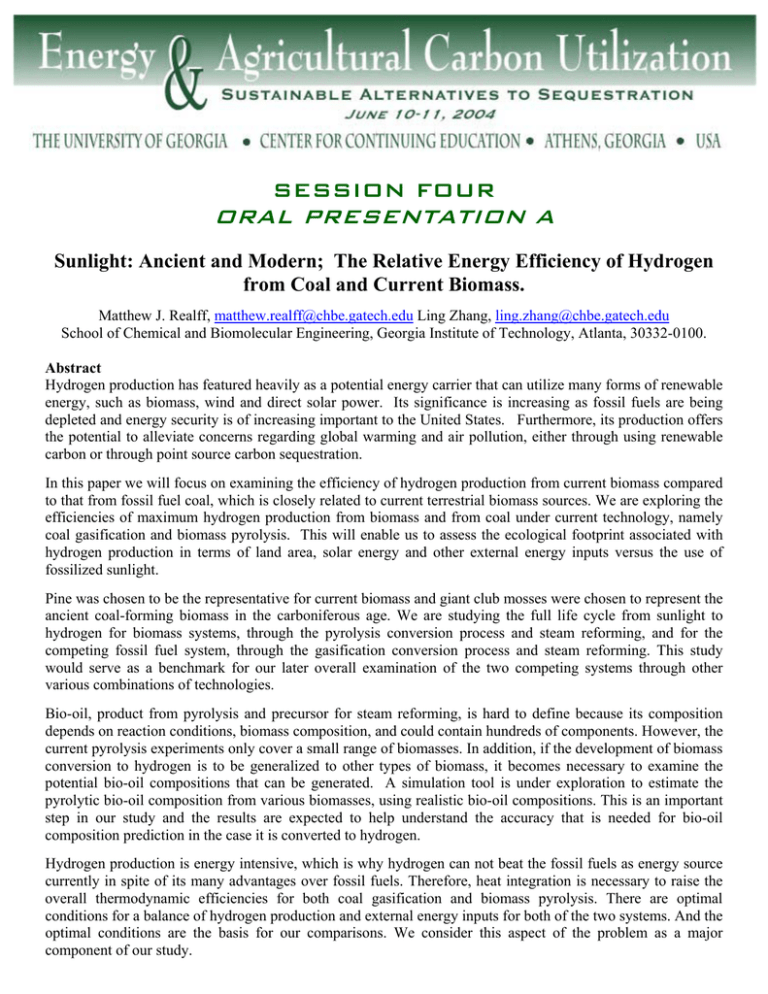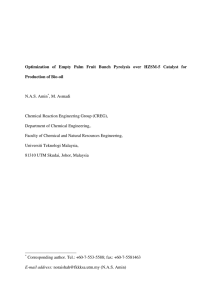ORAL PRESENTATION A SESSION FOUR
advertisement

SESSION FOUR ORAL PRESENTATION A Sunlight: Ancient and Modern; The Relative Energy Efficiency of Hydrogen from Coal and Current Biomass. Matthew J. Realff, matthew.realff@chbe.gatech.edu Ling Zhang, ling.zhang@chbe.gatech.edu School of Chemical and Biomolecular Engineering, Georgia Institute of Technology, Atlanta, 30332-0100. Abstract Hydrogen production has featured heavily as a potential energy carrier that can utilize many forms of renewable energy, such as biomass, wind and direct solar power. Its significance is increasing as fossil fuels are being depleted and energy security is of increasing important to the United States. Furthermore, its production offers the potential to alleviate concerns regarding global warming and air pollution, either through using renewable carbon or through point source carbon sequestration. In this paper we will focus on examining the efficiency of hydrogen production from current biomass compared to that from fossil fuel coal, which is closely related to current terrestrial biomass sources. We are exploring the efficiencies of maximum hydrogen production from biomass and from coal under current technology, namely coal gasification and biomass pyrolysis. This will enable us to assess the ecological footprint associated with hydrogen production in terms of land area, solar energy and other external energy inputs versus the use of fossilized sunlight. Pine was chosen to be the representative for current biomass and giant club mosses were chosen to represent the ancient coal-forming biomass in the carboniferous age. We are studying the full life cycle from sunlight to hydrogen for biomass systems, through the pyrolysis conversion process and steam reforming, and for the competing fossil fuel system, through the gasification conversion process and steam reforming. This study would serve as a benchmark for our later overall examination of the two competing systems through other various combinations of technologies. Bio-oil, product from pyrolysis and precursor for steam reforming, is hard to define because its composition depends on reaction conditions, biomass composition, and could contain hundreds of components. However, the current pyrolysis experiments only cover a small range of biomasses. In addition, if the development of biomass conversion to hydrogen is to be generalized to other types of biomass, it becomes necessary to examine the potential bio-oil compositions that can be generated. A simulation tool is under exploration to estimate the pyrolytic bio-oil composition from various biomasses, using realistic bio-oil compositions. This is an important step in our study and the results are expected to help understand the accuracy that is needed for bio-oil composition prediction in the case it is converted to hydrogen. Hydrogen production is energy intensive, which is why hydrogen can not beat the fossil fuels as energy source currently in spite of its many advantages over fossil fuels. Therefore, heat integration is necessary to raise the overall thermodynamic efficiencies for both coal gasification and biomass pyrolysis. There are optimal conditions for a balance of hydrogen production and external energy inputs for both of the two systems. And the optimal conditions are the basis for our comparisons. We consider this aspect of the problem as a major component of our study.






